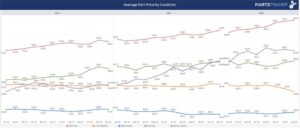The collision repair and insurance industries have been monitoring the impact of tariffs on collision parts prices since the administration announced, on April 2nd, the various tariff rates on parts-producing countries. I have also continued to use the Parts Inflation Market Basket — which I created over five years ago — to monitor the inflation rates on a specific set of collision parts by type (OEM, Aftermarket, Recycled, etc.). This market basket contains major parts such as hoods, fenders, lamps, wheels, and bumper covers, which are available in aftermarket, reconditioned, and recycled supply. Additionally, I track the inflation rate of price-matched OEM parts to see if inflation pressures impact this smaller category differently.
OEM and Aftermarket Pricing Trends
Since April, the New OEM inflation rate has been 4.3%. Until recently, aftermarket parts seemed to be largely inflation-resistant, holding at under 1%. That trend is now shifting. Many aftermarket distributors have told me they purchased significant additional inventory before tariffs took effect to maintain pricing. Now that pre-tariff inventory has sold, replacement stock is being purchased at prices that include the added tariff costs.
The Surprising Rise in Recycled Parts
An interesting development has been the inflation rate of recycled parts. Aside from some recycled sales exported from Canada to U.S. border cities, these should not be directly affected by tariffs — yet prices have been increasing. The reason is the weakened U.S. dollar.
The U.S. Dollar Index (USDX, DXY, DX — or, informally, the “Dixie”) measures the value of the U.S. dollar against a select group of foreign currencies, often referred to as a basket of U.S. trade partners’ currencies. On April 2nd, the index stood at 103.81; this week, it’s hovering around 98.5.
Why does this matter to recycled part pricing? Large U.S. salvage sellers report that roughly 36% of the total-loss vehicles they sell are exported and therefore never enter the U.S. parts harvesting ecosystem. I have also asked these sellers how many vehicles were sold to an American buyer when the next-highest bid came from a foreign buyer — which means the American buyer had to pay more to keep the car in the U.S. That figure is about 35%. Combined, foreign currency values influence roughly 71% of salvage sold in the U.S.
A weaker dollar brings more competitive foreign bidding, which drives up the cost of recycled parts domestically.
Looking Ahead
As we head into the fall, I believe we will continue to see higher prices for new OEM and recycled parts. I also expect to see more of the impact of tariffs on aftermarket parts — an effect that was previously masked by pre-tariff inventory that has now been depleted.

